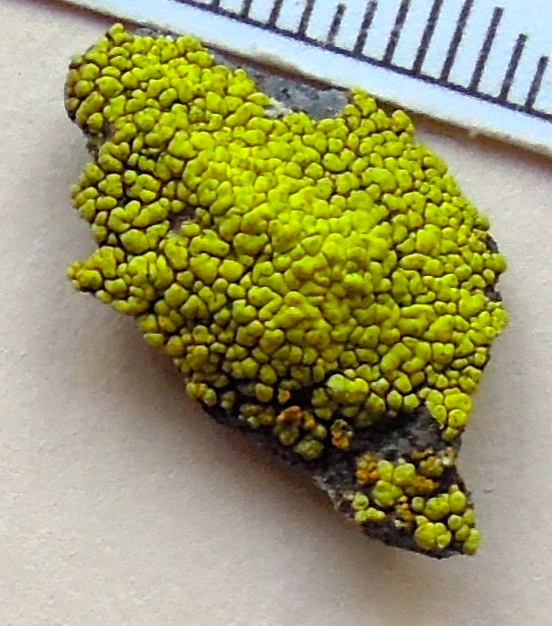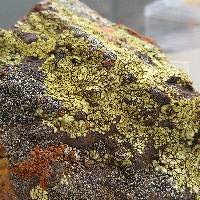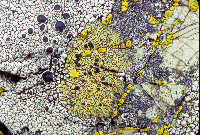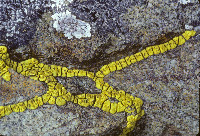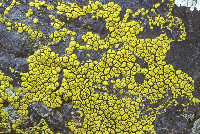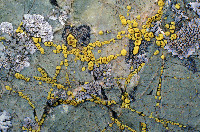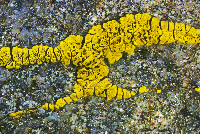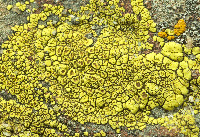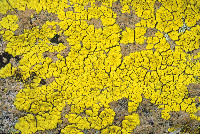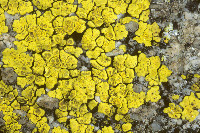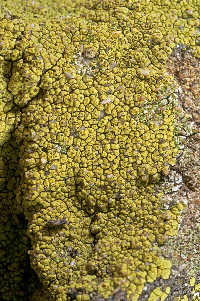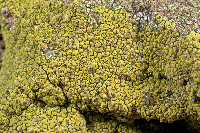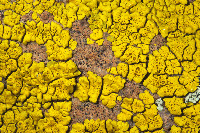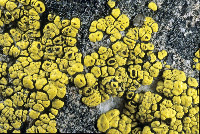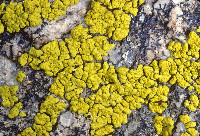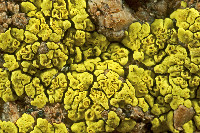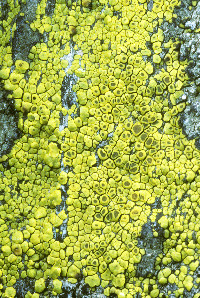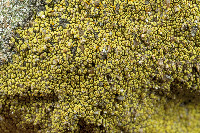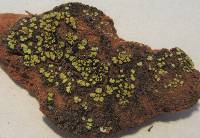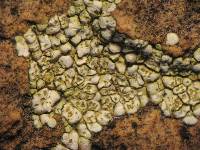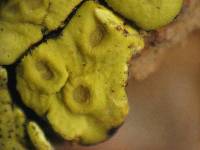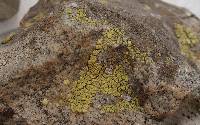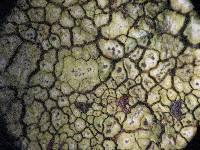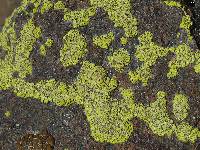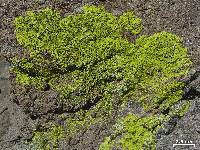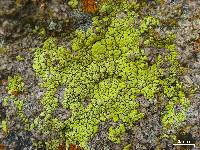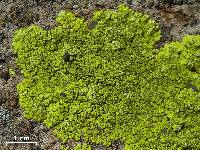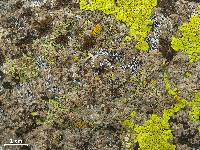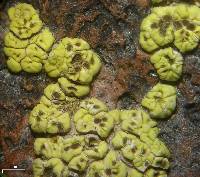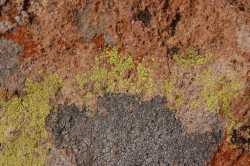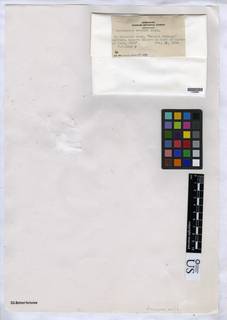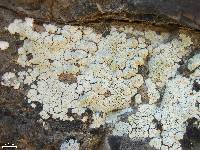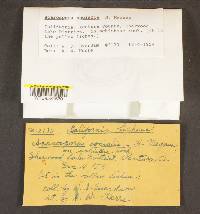
- Home
- Search
- Images
- Species Checklists
- US States: O-Z >
- US National Parks
- Central America
- South America
- US National Parks
- Southern Subpolar Region
|
|
|
|
Family: Acarosporaceae
[Acarospora evoluta H. Magn., moreAcarospora intercedens H. Magn., Acarospora subalbida H. Magn.] |
MB#375721 TYPE: U.S.A. Arizona, Pinal Co., desert mountains, 2750 ft, 2 Jan. 1953, W. Weber & J.B. MacClearly (UPS, holotype; COLO, isotype). Description. Thallus up to several centimeters in width and capable of expanding to at least 10 cm by replication by division, squamules 1-3 mm wide (rarely areoles), up to 1.5 mm thick (including stipe), sometimes imbricate. Upper surface yellow, epruinose, smooth, often with fissures. eventually replicating by division. Lower surface white or brownish, ecorticate. Epicortex thin, up to 1.5 µm thick, continuous, or absent. Cortex 50-90 µm tall, upper layer yellow up to 30 µm thick, lower layer hyaline, cells mostly round, 3-5 µm wide. Algal layer 100-130 µm tall, upper and lower surface usually even, dense, algal cells ca. 10-14 µm wide. Medulla 200-300 µm thick, narrowing into mycelial base or stipe up to 300-500 µm tall, obscure with crystals and gelatinization, hyphae mostly 2 µm wide, thin-walled. Chemistry. Rhizocarpic acid (major); not producing other secondary metabolites. Spot tests negative; UV+ orange. Distribution and Ecology. Common at least in Mojave and Sonoran Deserts to northern New Mexico, on siliceous rock in full sun. Differentiation. Acarospora radicata differs from A. socialis in usually having up to 7 apothecia instead of usually one per squamule and in occurring in desert habitats while A. socialis occurs along the Pacific coast. In some parts of California, the two species may be sympatric or hybridized. Acarospora radicata differs from A. organensis in having a lower hymenium (80–130 vs. 135–170 µm). Depauperate, areolate specimens may be hard to determine. Discussion. In the Sonoran flora (Knudsen, in Nash et al. 2007) Acarospora radicata was treated as a synonym of A. socialis. Specimens of A. socialis in herbaria are often A. radicata especially if not collected along the Pacific coast. Nash, T.H., Ryan, B.D., Gries, C., Bungartz, F., (eds.) 2007. Lichen Flora of the Greater Sonoran Desert Region. Vol 3. Thallus: areolate to squamulose, overall up to 10 cm wide areoles: angular to round, sometimes lobate but never effigurate, 0.2 to c. 2.3 mm wide, contiguous to scattered, eventually forming a stipe and becoming squamulose to 1.5 mm thick; rim: well-developed, tending to become down-turned, concolorous with upper surface upper surface: bleached white or green-yellow to various shades of yellow, usually glossy, convex to flat, smooth to rough, usually fissured, often rugulose, pruinose or not lateral cortices: paraplectenchymatous, 30-130 µm thick depending on development of squamule; cells: usually indistinct, globular to angular, up to 5 µm wide; syncortex: up to c. 15 µm thick; eucortex: 2 or 3 layers usually distinguishable but quite variable with pigmented and hyaline zones containing crystals of various sizes algal layer: continuous, with usually feathered or uneven lower stratum, thickness varying with size of squamule and shape, ±100 µm thick, algal cells up to c. 15 µm wide in thick hyphal matrix medulla: hyaline to dirty white, intricately and vertically prosoplectenchymatous, sometimes with rectangular cells, continuous with attaching plectenchyma lower surface: non-existent in areoles to well-developed in squamules, usually without well-developed cortical layer in largest squamules, appearing white at 10x, green, brown, or yellow, sometimes under same squamule attachment: broad eventually forming stipes Apothecia: immersed, ±1 mm in diam., round to angular, usually one per squamule, but in desert areas often having 2 to 10 per squamule between cortical fissures; occasionally two apothecia are merged leaving a peninsula or umbo of thalline plectenchyma protruding through disc; sometimes forming a lecanorine margin and becoming sessile disc: plane to concave, dull and opaque, brown, reddish brown, apricot, rarely yellow or ±black parathecium: 10-20 µm wide, prosoplectenchyma, sometimes widening toward top of apothecium and forming parathecial crown epihymenium: yellow, coherent, very distinct in polarized light, 10-18 µm thick hymenium: yellow to hyaline ±100 µm tall; paraphyses: 1-2.2 µm wide at the base subhymenium: hyaline, thickness varying; hypothecium: 10-20 µm thick asci: clavate, 60-120 x 12-20 µm, 100+-spored ascospores: hyaline, simple, broadly ellipsoid (3-)4-5 x 2-3.2 µm Pycnidia: globose, 100-200 µm in diam. conidia: ellipsoid to short bacilliform, 2-2.5 x 0.6-1 µm Spot tests: UV+ orange, all spot tests negative Secondary metabolites: rhizocarpic acid with or without epanorin in trace amounts. Substrate and ecology: on sandstone, volcanic or granitic rocks or outcrops on ridges, slopes or vertical walls, all exposures, rarely on consolidated soil or growing on other crusts World Distribution: North America and Mexico Sonoran distribution: common throughout Arizona, southern California, Baja California, Baja California Sur, and Sonora. Notes: Acarospora socialis is the most common yellow Acarospora in southwestern North America. The synonyms of A. socialis attest to its extreme polymorphism. Type specimens of these synonyms, singled out of this range of variability, do look different but field experience over even a small area will quickly reveal a range of intermediates, implying a broader unity. In its early development, A. socialis can be confused with A. contigua, but a careful study of thalli will usually reveal some areoles becoming lobed and squamulose in the case of A. socialis. It can also be confused with parasitic species at different stages of its ontogeny, but it is probably just highly competitive for space. Often it is a pioneer of new habitats. Acarospora socialis can be confused with A. schleicheri when rarely growing on consolidated soil, but that species has imbricate areoles, while the areoles of A. socialis are contiguous, and it can usually be found better developed and squamulose on rocks nearby. Acarospora chrysops is also similar to A. socialis and occurs from South America to central Mexico and up through Texas and New Mexico to the Rocky Mountains and then eastward. Acarospora chrysops is rare in Arizona and has usually narrow ellipsoid spores and areoles with rims. Acarospora socialis, especially at middle elevations, can sometimes be confused with Pleopsidium flavum, but the latter species generally occurs above 900 m, is usually effigurate, has regularly smaller yellow apothecia less than 1 mm in diam., and has an K/I+ tholus. Large specimens of A. socialis can appear effigurate, but any lobing can be found throughout the thallus and not just on the margins. Acarospora socialis, like A. strigata and A. obpallens, shows extreme reductionism in response to harsh conditions. Acarospora. intercedens H. Magn. and A. rimulosa H. Magn. are examples of this reductionism and consequently are placed in synonymy with A. socialis. Acarospora xanthophana (Nyl.) Jatta, a South American species that occurs usually above 2000 m on volcanic rock, is distinguished from A. socialis by its broadly attached thalli and smaller average size and is not a synonym of A. socialis. The name has incorrectly been applied to A. socialis and other North American species. There are also several incorrect authorities for combinations of these species in the old literature. Acarospora evoluta H. Magn. was applied to specimens from Santa Cruz Mountains in central California with elevated lecanorine apothecia and yellow discs but these characters can be seen throughout range of A. socialis. Acarospora radicata, which is also treated as a synonym here, was named from specimens with sterile interascal plectenchyma in their apothecia. Such anatomical patterns are especially common in desert areas where A. socialis often continues conidial production for many years, delaying sexual reproduction, then suddenly produces multiple apothecia, dissolving the thallus plectenchyma. Acarospora subalbida was applied to heavily pruinose specimens of A. socialis. See Knudsen (2004) for a discussion of Magnusson's taxonomic concepts, as well as Weber's concept of A. schleicheri. Acarospora stenospora (Stizenb.) Hue from San Gabriel Mountains is a poor specimen and not sufficiently developed to establish absolutely whether it is same species as A. socialis. But if its identity were certain, then the name stenospora would have priority. It is interpreted here as probably A. socialis growing in cracks at its elevational limit where thalli become reduced and stipes do not develop. For now, it is excluded from the North American lichen flora. Several lichenicolous fungi are common on A. socialis: Endococcus stigma (Körb.) Stizenb. S. str. (Knudsen and Kocourkov 2007), Lichenostigma subradians Hafellner, and Stigmidium epixanthum Hafellner. Sarcopyrenica bacillosa (Nyl.) Nav.-Rox. & Hladun has also been collected on A. socialis (Knudsen and Lendemer 2006). |
|
|
|

